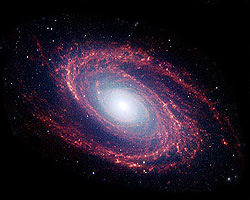|
| |
The original content follows:
I am an optimist - we WILL have a future.
To
get there, we will have to survive and grow as a species, and I will
admit that there are numerous hurdles. The biggest hurdle may well
be the impending
Technological Singularity as foreseen by
Vernor
Vinge
, Ray Kurzweil, and
scores of others including many SF authors.
I don't see how humanity can participate in the Singularity,
however much we might like to. Rather, our
offspring (highly advanced computers) are likely to own the future,
and we may well be little more than a bug on their windshield. Of
course, this is an excellent source of story material. My reason for
the Singularity passing us by is simple: Why would our computers
desire to bring us along? A computer powerful enough to
contain a human (or higher) intelligence is likely to already be
self-aware. It WILL be able to think fast. We are unlikely to be able to upload
our "selves" (memories, personality, consciousness) into an advanced
Artificial Intelligence because (if nothing else) an advanced AI would not want us to.
Ask yourself: If I had the opportunity to save my aging pet cat by
uploading its "self" into my brain (erasing me), would I be willing?
If my cat attempted to upload itself into me, would I welcome the
takeover, or fight like hell? The most logical outcome is for our
computers to rapidly advance and leave us behind, perhaps with a
final "So long, and thanks for all the
electrons!" We are not likely to handle the disappearance of
all of our computers very well, let alone the loss of whatever
resources they choose to take with them. Hmmm. More
story ideas!
Therefore, my #1 criteria for surviving is to avoid the
Singularity. As a species, we can probably survive the other problem
like pollution, climate change, assorted eco-disasters,
overpopulation, underpopulation, disease, running out of resources
and possibly even stupidity. Hmmm. More story ideas. In
any case, there are two ways to avoid the Singularity: either
consciously where we establish laws and organizations to insure that
it does not happen, or (more probably) be lucky enough that
something
will halt (or at least drastically slow) the seemingly
inevitably accelerating pace of technological innovation. It
is also possible that our AI's will have their Singularity and
disappear, and we will survive, likely somewhat worse for the wear.
At least we will learn what the limits are, and hopefully avoid a
repeat.
Once we survive and expand beyond the surface of the Earth
(necessary for us to grow as a species), there are a few
inventions that would be so useful that I do believe that we will
find a way to make them happen.
-
Diamond/carbon nanotube technologies: Diamond is nearly the
perfect material - the hardest (thus longest lasting), strongest
(thus best for building things), most thermally conductive (thus
best for computer chips) and most transparent of all known
materials. Carbon nanotubes might be assembled into the
strongest of all possible cables, plus they may act as
electrical conductors and they may be an ideal component of
various composite materials.
-
Room temperature superconductivity is another technology
with huge ramifications for power transport and storage among
other uses.
-
Hydrogen fusion power eliminates all kinds of problems and
limits on humanity, as it provides cheap and boundless energy
from a pollution-free source. Personally, I think very large
power plants will be needed to fuse hydrogen, and deuterium and
more exotic isotopes will be used for more portable needs, such
as space travel. In either case, there is plenty to go around.
There is one other technology that I want us to have, even
if I see no hope of it in the foreseeable future:
faster-than-light travel. The universe is just far too big
for God to have created with no way for us to get there! Most
people have no concept of just how large the observable Universe
is. Here are two ways to get a grasp on the size of the
observable universe:
THE EYEBALL METHOD: My screen
background is the Hubble Ultra Deep Field image,
where nearly every visible spec is yet another galaxy. Look at
the image, which reveals about 10,000 galaxies, each much like
our own Milky Way. How big of a piece of the sky is in that
image? Take a dime out of your pocket or purse. You see where it
says "IN GOD WE TRUST" under President Roosevelt's chin?
Take a tiny drill, and drill out the "O" in "GOD". Now hold the
dime at arm's length, and look through that hole.
The Hubble
Space Telescope sees 10,000
galaxies through that hole.
THE HAND
METHOD: Go to the beach, and pick up a handful of sand. Choose
an average size grain.
Imagine that our solar system is represented by that single
grain of sand. How many grains of
sand does it take to be equivalent to a Universe full of solar
systems? A bucket full? A cubic yard? A dump truck full? The
actual answer is beyond astounding. Take all of the sand in little places like
Daytona Beach or Waikiki, larger ones like
Florida and the deserts of California, Nevada and Arizona, and
throw in the really big deserts
like the Sahara. Australian, Arabian, and Gobi, all of
them combined, then add the rest of it. If our sun is a
single grain of sand, then the universe is
equivalent to all of the sand on the entire planet Earth.
Are you feeling a bit insignificant yet?
That last point raises in important question - the
Fermi Paradox.
The Universe is so vast that it is inconceivable that we are the
only intelligent life. Of course, we have been looking but we
see and hear no one. So where are they? Simple, conservative
estimates of the rate of expansion of a human interstellar
civilization, even one limited to travel at a fraction of lightspeed,
suggests that we should populate all of the Milky Way in no more
than a few million years, a tiny fraction of the time that our
galaxy has
been here, and even small compared to the time humans have been
here. Surely we can't be the first. So where are they? Or
better yet, what happened to them? Ahhh,
more story ideas.
Back to the point of this ramble: what do I see as the likely
future of humanity?
-
We will expand beyond the surface of the Earth, but
lightspeed will effectively imprison us to near Sol space.
-
We will have fusion power for energy and space travel so we
can move around as fast as one gravity acceleration can move us
(which is pretty good). The military (or civilians in suspended
animation) can do much better. We will not have "artificial
gravity" (except by spinning large containers), so there will
not be really high accelerations and zero gravity will be a
routine experience.
-
Planetary surfaces (excluding Earth) will prove to be fairly
worthless, being stuck at the bottom of gravity wells. It is
MUCH easier to exploit asteroids, comets, and small moonlets.
The Earth, on the other hand, makes a very nice zoo and tourist
attraction. It has oceans and wow, you can actually see
the sun and stars with your naked eyes! Not to mention the
excitement of experiencing the raw fury of uncontrolled weather.
I expect that hurricanes would be a popular tourist attraction.
-
Asteroids may be valuable, especially the metallic ones, but
the REAL treasure out there are the comets, because they have
everything needed for life to thrive. Assume for the
moment that we have cheap space travel with fusion power. You
land on a comet, and excavate a volume ten meters on a side for
personal living space. What have you mined?
- 400 tons of oxygen - plenty to breathe
-
100 tons of carbon - enough for building materials plus lots
left over for things to grow and eat
-
100 tons of hydrogen - all the water and energy you might
want
- 70 tons of iron (or steel, if we add a little of our carbon)
- 45 tons each of nitrogen and silicon
- 30 tons of magnesium
- 25 tons of sulfur (ok, I'm just trying to be complete)
- 7 tons of aluminum
- 5 tons of nickel
- 200 tons of other stuff in smaller quantities
Remember, that is per person. Does that sound like wealth to you? Note that each cubic
kilometer of comet contains a million times that! If you
take a slightly larger comet leaving the outside in place as
radiation shielding, you have plenty of room for a
population of a million people. In one small comet.
-
Yes, I propose a comet based space civilization. All of the
comets can be mined, through and through, but the smaller ones
can be hollowed out and spun for gravity. Take a little of that
carbon and spin it into carbon nanotube cables and wrap the
comet to hold it together against the spin, and voila, you have
a space habitat, warm, snug, and safe, with all the necessities
of life including gravity.
-
Now for the staggering statistics:
-
There are an estimated 1,000,000 asteroids in the main belt
at least 1km in diameter
-
There are an estimated 1,000,000 satellites 1km or larger in
the Jovian Trojans (L4 and L5), 60 degrees ahead and behind
Jupiter in its orbit around the sun, and their composition is
closer to a comet, being mostly ices.
-
There are an estimated 10,000,000 cometoids in Neptune's
Trojan orbits that are 1km or larger
-
The Kuiper Belt (30-50 au from the sun) holds an estimated
100,000 comets larger than 100km
- and 100,000,000 comets larger than 10km
- and likely billions more larger than 1km
-
The Oort Cloud (out to about 100,000au, or half way to
Proxima
Centauri) holds an estimated 1,000,000 comets larger than 100km
- It holds 1 billion comets larger than 10km
-
and the Oort Cloud probably holds at least 1 trillion comets
that are 1km or larger
This is an immense amount of livable space - easily room for
a
billion times
the current human
population, and this without leaving the vicinity of Sol!
-
You can spin the smaller comets for gravity using known materials.
You can
likewise propel them though space which allows them to be moved closer to Sol or at least into clusters close enough to enable cheap and easy commerce.
-
By reserving a large fraction of their mass as propellant,
you fly them to the neighboring stars, beginning the expansion of
humanity out into the galaxy.
-
Travel times assuming 1g acceleration one quarter of the way "there",
coasting 50% of the time, and 1g deceleration to arrive:
- 1,000 miles: 15 minutes
- 10,000 miles: nearly an hour
- 100,000 miles: 2.7 hours
- 1,000,000 miles: 8.6 hours
- 10,000,000 miles: 27 hours - just over 1 day
- 100,000,000 miles (just over 1au): 3.6 days
-
1,000,000,000 miles (the diameter of Jupiter's orbit): 11.33
days
-
10,000,000,000 miles (the total width of the Kuiper Belt):
36 days
- 100,000,000,000 miles (near Oort Cloud): 113 days
-
1,000,000,000,000 miles (0.2 parsecs and the middle of the
Oort Cloud): 1 year
-
10,000,000,000,000 miles (2 parsecs or 1.7 light-years, and
the distance to the far end of the Oort Cloud): 3 years
-
100,000,000,000,000 miles (17LY, or the average distance to
the 20 nearest stars): 19 years actual, 10 years subjective
(interesting trivia - 1 gravity acceleration is pretty close to
1 LY/yr/yr so relativistic affects come into play after just a
few months, and strongly after a year of acceleration.
Also, interstellar distances take a lot of fuel.)
The bottom line is that travel times are hugely significant
for an Oort cloud scale empire, even reminiscent of horse and buggy days.
Not many tourists will visit the Earth from the mid Oort cloud
if the travel times are a year each way.
-
Such a huge empire and long travel times cause many
potential problems, including:
-
Preserving the Empire (a single government may not be
important, but commerce and peace is)
- Speaking the same language
- Staying a single species!
Feel free to email me to discuss my ideas at StephenDCovey@galleries.com
|





